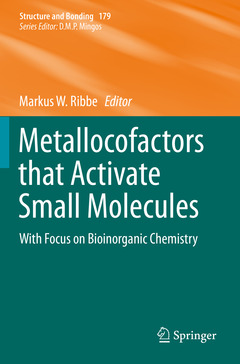Metallocofactors that Activate Small Molecules, 1st ed. 2019 With Focus on Bioinorganic Chemistry Structure and Bonding Series, Vol. 179
Coordonnateur : Ribbe Markus W.

Presents an overview of the fundamental chemistry of metallocofactors within the field of bioinorganic chemistry
Provides a review of the mechanistic understanding of metallocofactors
Multi-authored volume with contributions from world renowned experts in the field
Date de parution : 09-2020
Ouvrage de 169 p.
15.5x23.5 cm
Disponible chez l'éditeur (délai d'approvisionnement : 15 jours).
Prix indicatif 295,39 €
Ajouter au panierDate de parution : 09-2019
Ouvrage de 169 p.
15.5x23.5 cm
Disponible chez l'éditeur (délai d'approvisionnement : 15 jours).
Prix indicatif 295,39 €
Ajouter au panier


